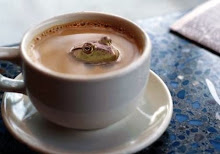During my experimentation of various dance techniques and styles, I was exposed to a wondrous concept called TaKeTiNa. TaKeTiNa is a concept that involves chants, simple footwork, clapping and rhythms. The process engages in a sense of community that brings voices, energy and focus together.
There isn't a whole lot of available online footage so all I can do is work with what I've got. The below video is short introduction to the concept of TaKeTiNa, brought to us by two individuals who went through the TaKeTiNa training program.
TaKeTiNa with Shasta and Brian
The TaKeTiNa process was developed in 1970 by Austrian musician Reinhard Flatischler. His wife Cornelia joined him in 1989. Since then the two have lead trainings and workshops all over the world.
The process is always accompanied by the Berimbau (Brazlilian single-string percussion instrument, a musical bow) and Surdo drum (commonly used in Brazil). Call and response singing and chanting are incorporated with simple foot stepping and other rhythmic movements. As rhythms and chants change, participants may fall out of rhythm and the individual is able to explore the experience of falling in or out of touch with what they know.
Below is a brief trailer to the work of Reinhard and Cornelia Flatischler. The footage is in German however, you will gain some insight into the process.
TaKeTiNa and Intuition by Reinhard and Cornelia Flatischler
Reinhard Flatischler has involved himseldf in what he calls "TaKeTiNa Rhythm-Research Project". Flatischler and the Head of the Deutschen Gesellschaft für Schmerztherapie (German Association for Pain Therapy), Dr. Gert Müller-Schwefe, collaborated in researching the effects of rhythm on the nervous system and consciousness.
The measures listed below are taken directly from the website.
1) Long-term measurement of heart rate variability (HRV) with breath rate.
We use the display method developed by Dr. Lohninger that enables changes to be seen on the monitor at the time they occur.
2) Electroencephalograph (EEG) measurements before, during and after the TaKeTiNa process.
Dr. Michael Überall is one of the leading experts in EEG evaluation. The mainframe computer he developed enables the recognition of significant connections within the immense amount of data that is amassed over longer periods of time.
3) Smardwatch® measurements before, during and after the TaKeTiNa process.
The Smardwatch® System, which was developed by Chronomar, is a multi-parametric monitoring system for recording vital parameters. It results in profound insights concerning the development of control systems in the body.
We use the display method developed by Dr. Lohninger that enables changes to be seen on the monitor at the time they occur.
2) Electroencephalograph (EEG) measurements before, during and after the TaKeTiNa process.
Dr. Michael Überall is one of the leading experts in EEG evaluation. The mainframe computer he developed enables the recognition of significant connections within the immense amount of data that is amassed over longer periods of time.
3) Smardwatch® measurements before, during and after the TaKeTiNa process.
The Smardwatch® System, which was developed by Chronomar, is a multi-parametric monitoring system for recording vital parameters. It results in profound insights concerning the development of control systems in the body.
Research is ongoing however, at this time findings indicate that external rhythmic work like TaKeTiNa and internal autonomous rhythms. These findings are considered to be positive results within areas of stress research.
TaKeTiNa was always a great experience for me. The sound of my voice amongst the voices of others brought forth a sense of community. The unification of our energies seemed to bring forth a focus. The steps and stomps of our feet introduced a feeling of control and assertion into the ground. The clap of our hands emphasized the actualization and enjoyment of something tactile. The sound of voices chanting and the exertion of monotone harmonies offered a sense of calm.
For more information, to purchase merchandise and to learn about future workshops and trainings, visit the official website, here.



No comments:
Post a Comment